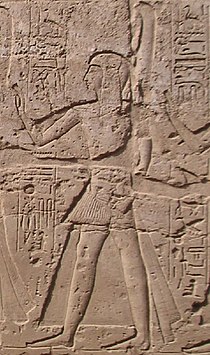Ramesses (prince)
| Ramesses in hieroglyphs | |||||||
|---|---|---|---|---|---|---|---|
Ramesses | |||||||
Ramesses | |||||||
 | |||||||
Ramesses (sometimes referred as Ramesses B) was an
Family
Ramesses was the eldest son of
Life

He is attested in numerous inscriptions including the Egyptian 'triumph' scenes after the Battle of Kadesh.[2] Ramesses bears the titles of Royal scribe, Generalissimo and "bodily King's Son beloved of him", and is shown presenting the "Maryannu-warriors of the despicable Naharina" to the gods as spoils of war. In scenes from the battle of Qode in year 10 at Luxor, the princes Amunherkhepeshef, Ramesses, Pareherwenemef and Khaemwaset are shown leading prisoners before their father the king.[3]
Ramesses is depicted as just one of two princes depicted by the colossi of Ramesses II in front of the Great Temple at Abu Simbel. He appears in front of the colossus to the north of the entrance. Prince Ramesses is said to be the Royal Scribe and first Generalissimo of His Majesty, Bodily King's Son (of his body).[3]
Ramesses served as the heir to the Egyptian throne from around year 25 to year 50 of his father's reign.[2] He succeeded his older half-brother Amunherkhepeshef as heir to the throne after his death.[1]
He has also attested in
Prince Ramesses is depicted in the Speos of West Silsila on a royal family stela dating to ca. year 30, and on a family stela from Aswan. On these stelae he is accompanied by his parents and his brothers and sister. Ramesses and Khaemwaset together appear on a statue group with their mother Queen Isetnofret which is now in the Louvre (Louvre 2272).[3]
Death and burial

After his death around year 50 of Ramesses II, he was buried in Tomb
See also
References
- ^ ISBN 978-0-85668-215-5
- ^ ISBN 0-500-05128-3
- ^ a b c d Kitchen, K.A., Ramesside Inscriptions, Translated & Annotated, Translations, Volume II, Blackwell Publishers, 1996
